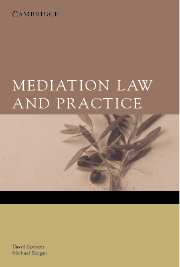Book contents
- Frontmatter
- Contents
- Acknowledgements
- Preface
- List of tables and figures
- Table of statutes
- Table of cases
- PART I THE PRACTICE OF MEDIATION
- PART II THE LAW OF MEDIATION
- 8 Mandatory Mediation
- 9 Confidentiality
- 10 Settlement Agreements
- 11 State Sponsored Mediation
- 12 Mediation Clauses in Contracts
- 13 Liability in Mediation
- 14 The Future of Mediation
- Bibliography
- Index
11 - State Sponsored Mediation
Published online by Cambridge University Press: 05 June 2012
- Frontmatter
- Contents
- Acknowledgements
- Preface
- List of tables and figures
- Table of statutes
- Table of cases
- PART I THE PRACTICE OF MEDIATION
- PART II THE LAW OF MEDIATION
- 8 Mandatory Mediation
- 9 Confidentiality
- 10 Settlement Agreements
- 11 State Sponsored Mediation
- 12 Mediation Clauses in Contracts
- 13 Liability in Mediation
- 14 The Future of Mediation
- Bibliography
- Index
Summary
Introduction
In the early 1980s the only way to conduct a mediation in Australia was if one or more of the disputants knew a mediator who could act for them to conduct a private mediation. (This presumes that disputants themselves actually knew what mediation was, and its potential benefits.) Mediation was not well used in the private sphere. In 1985 Sir Laurence Street made a recommendation to the New South Wales government to establish the Australian Commercial Disputes Centre (ACDC) in order to, among other things, promote non-adversarial dispute resolution into Australia. Since its establishment in 1986, the ACDC has achieved its goal in promoting dispute resolution among the commercial and non-commercial communities in Australia, and continues to do so today. In 1988, the Australian Dispute Resolution Association was established to similarly promote dispute resolution and develop standards of practice for dispute resolution. In 1989 Lawyers Engaged in Dispute Resolution (LEADR – now known as Leading Edge Alternative Dispute Resolution) formed to, among other things, promote the use of dispute resolution, provide a forum for dispute resolution practitioners to share common experiences and be a lobbyist for the dispute resolution profession.
Although a great amount of work was done by dedicated individuals, usually on their own time and without remuneration, the take-up rate of mediation and other forms of dispute resolution was slow.
- Type
- Chapter
- Information
- Mediation Law and Practice , pp. 377 - 407Publisher: Cambridge University PressPrint publication year: 2007



